Abstract
Treacher Collins syndrome (TCOF1) is an autosomal dominant disorder of craniofacial development, the features of which include conductive hearing loss and cleft palate. The TCOF1 locus has been localized to chromosome 5q32-33.2. In the present study we have used the combined techniques of genetic linkage analysis and fluorescence in situ hybridization (FISH) to more accurately define the TCOF1 critical region. Cosmids IG90 and SPARC, which map to distal 5q, encompass two and one hypervariable microsatellite markers, respectively. The heterozygosity values of these three markers range from .72 to .81. Twenty-two unrelated TCOF1 families have been analyzed for linkage to these markers. There is strong evidence demonstrating linkage to all three markers, the strongest support for positive linkage being provided by haplotyping those markers at the locus encompassed by the cosmid IG90 (Zmax = 19.65; theta = .010). FISH to metaphase chromosomes and interphase nuclei established that IG90 lies centromeric to SPARC. This information combined with the data generated by genetic linkage analysis demonstrated that the TCOF1 locus is closely flanked proximally by IG90 and distally by SPARC.
Full text
PDF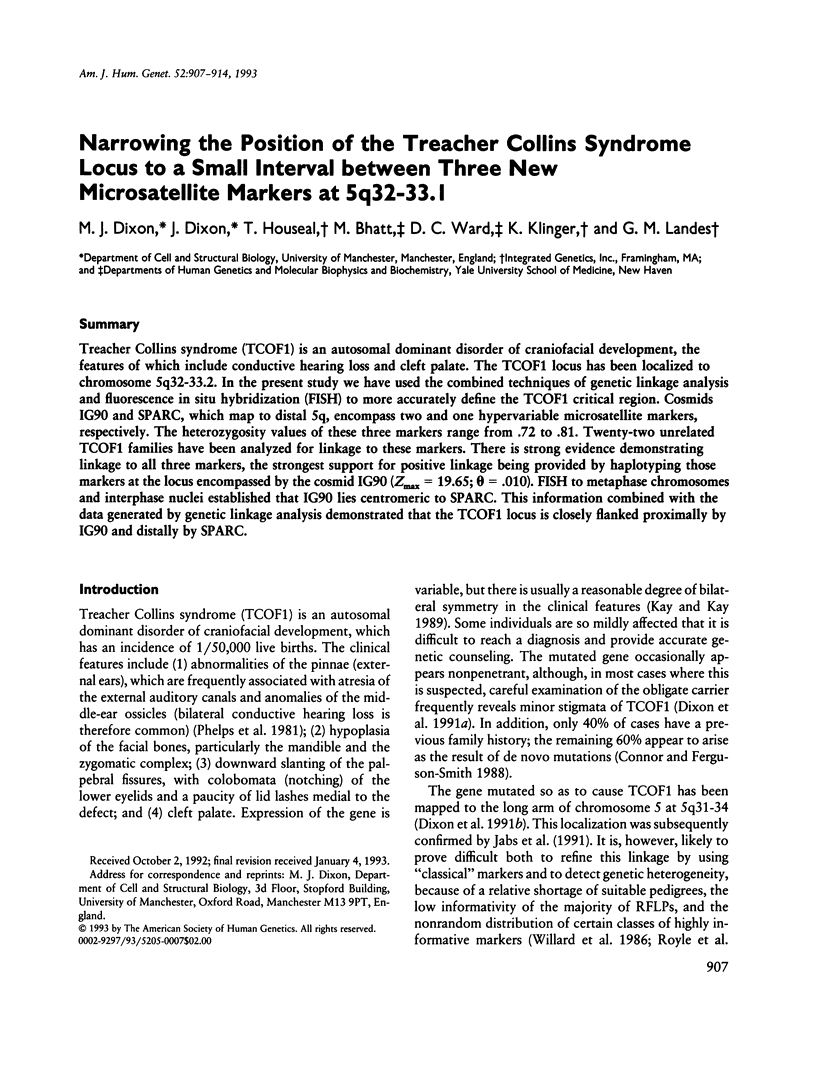
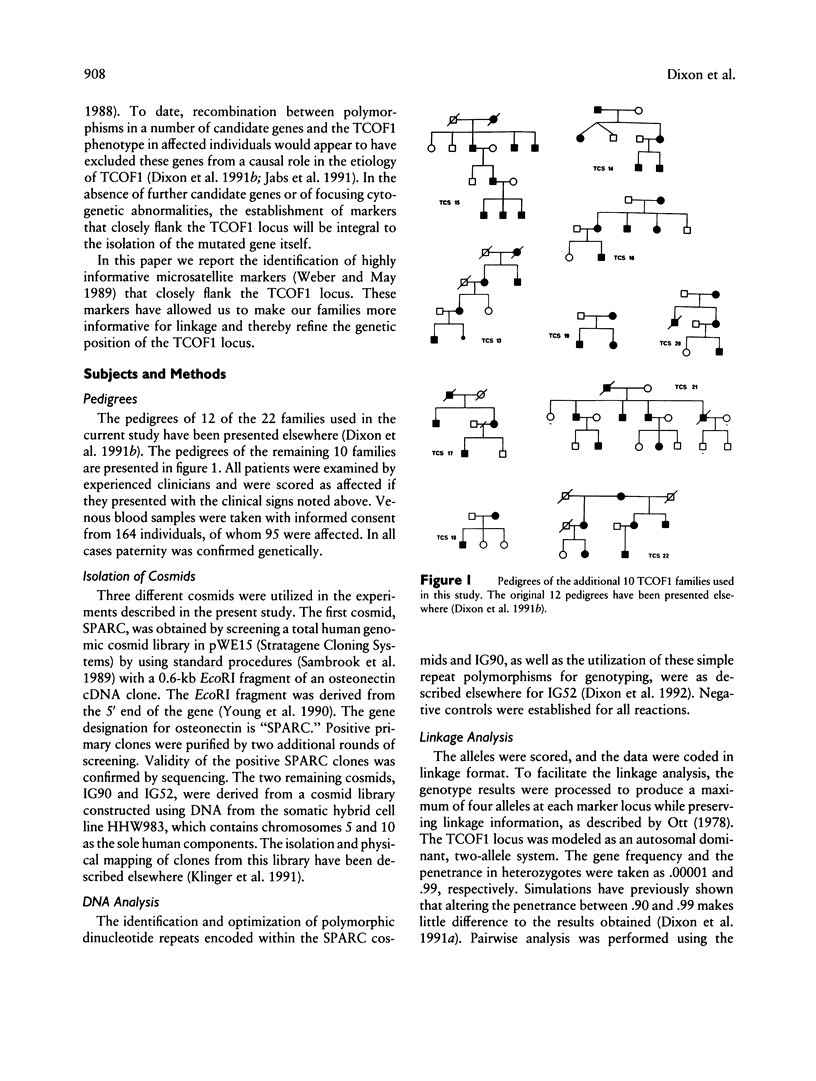
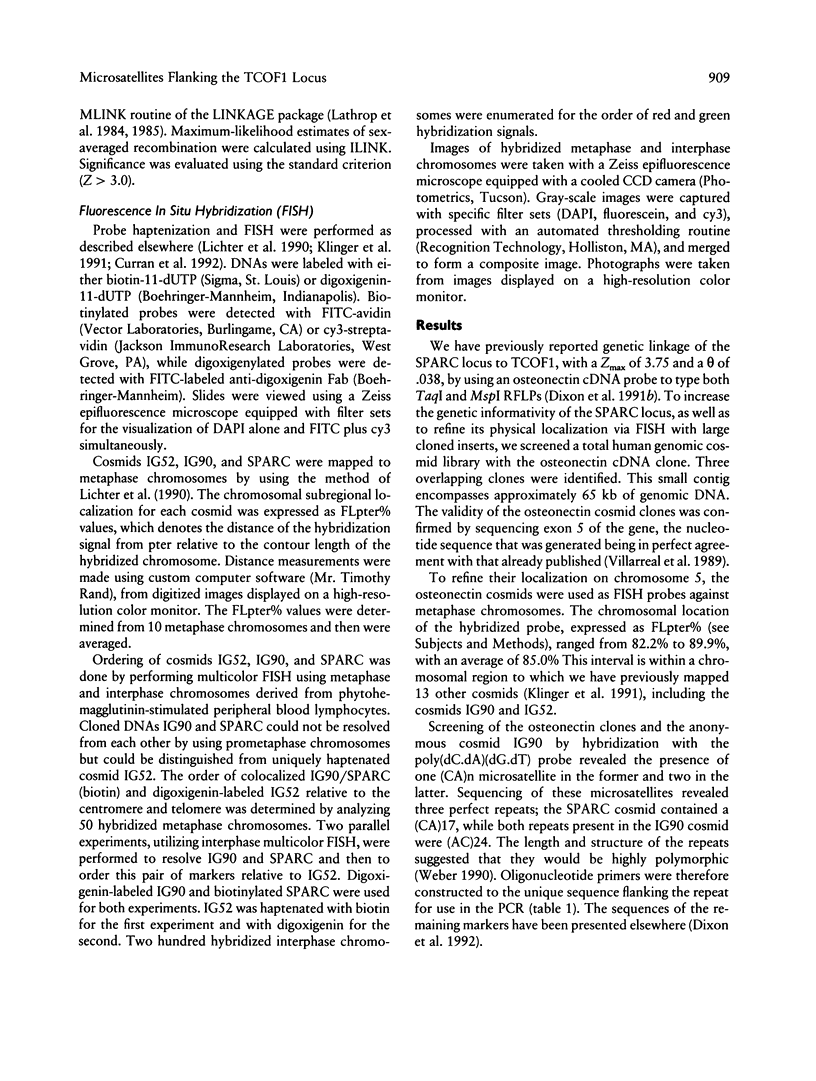
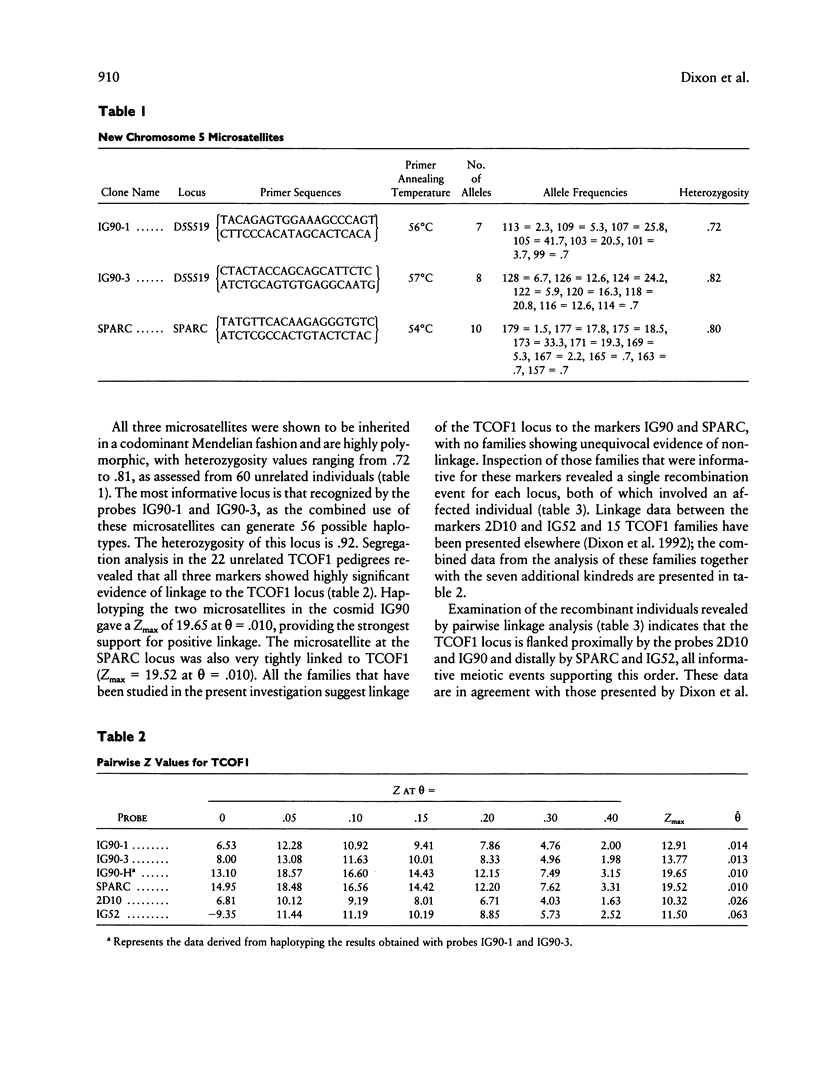
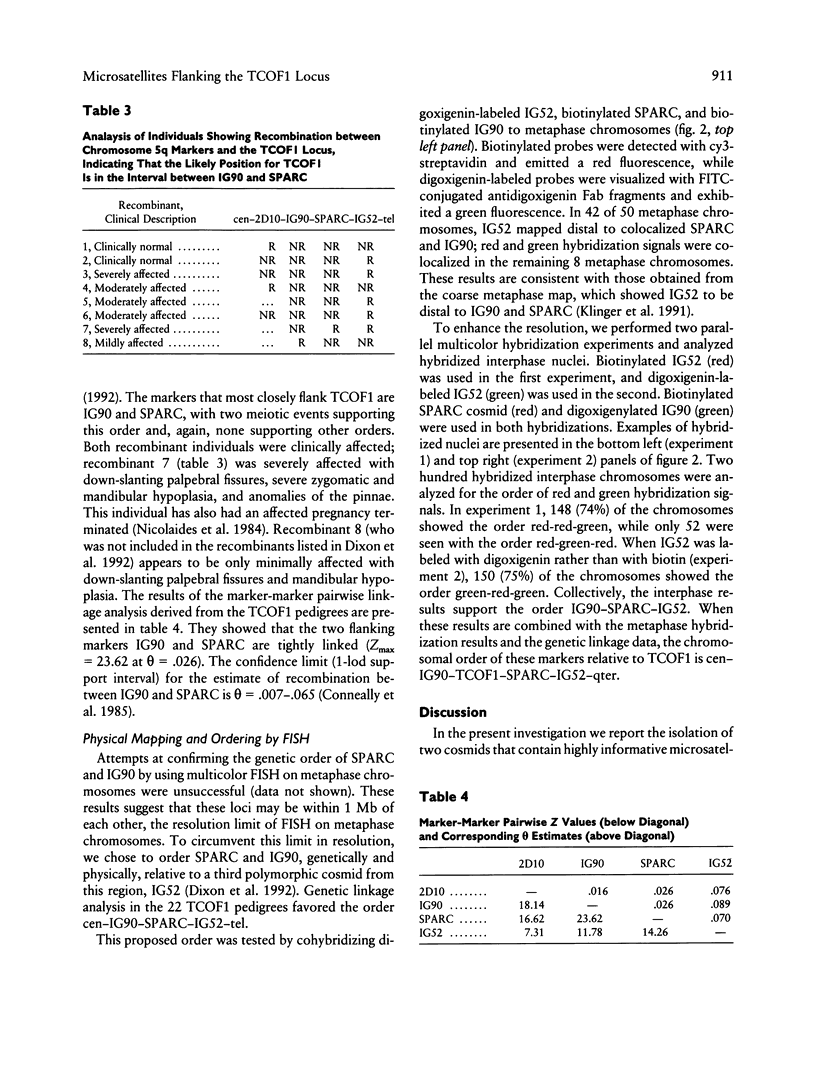
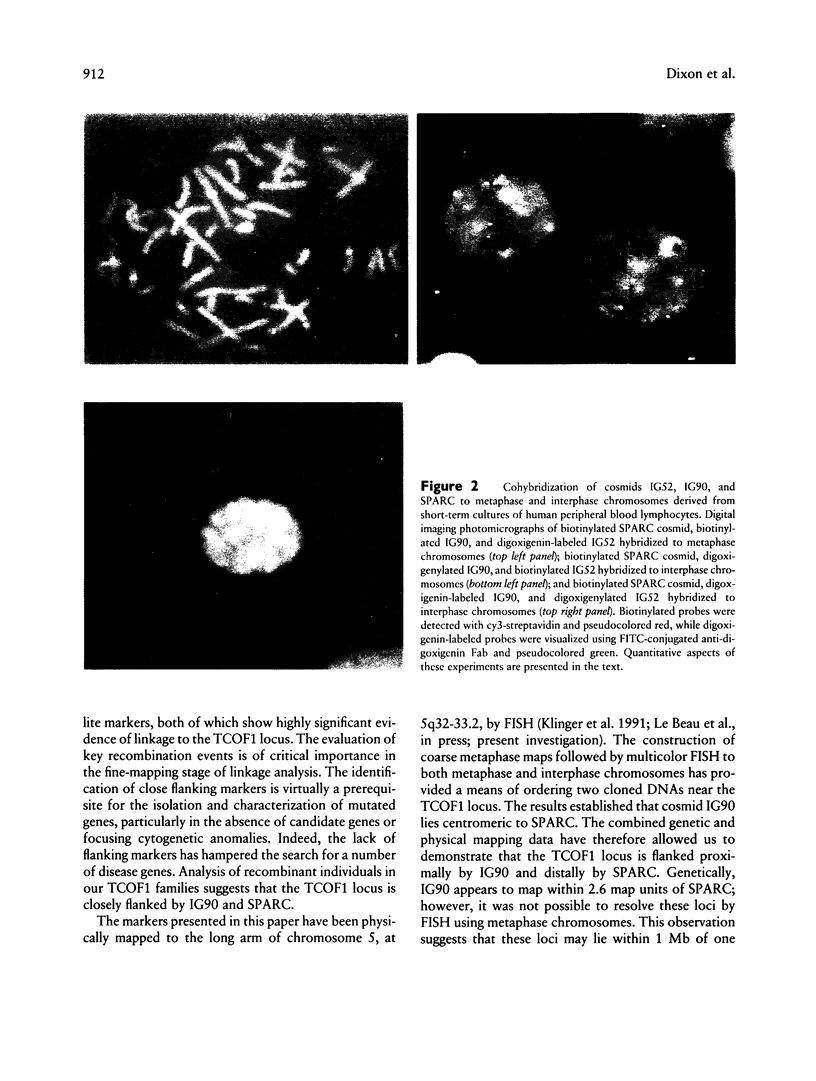
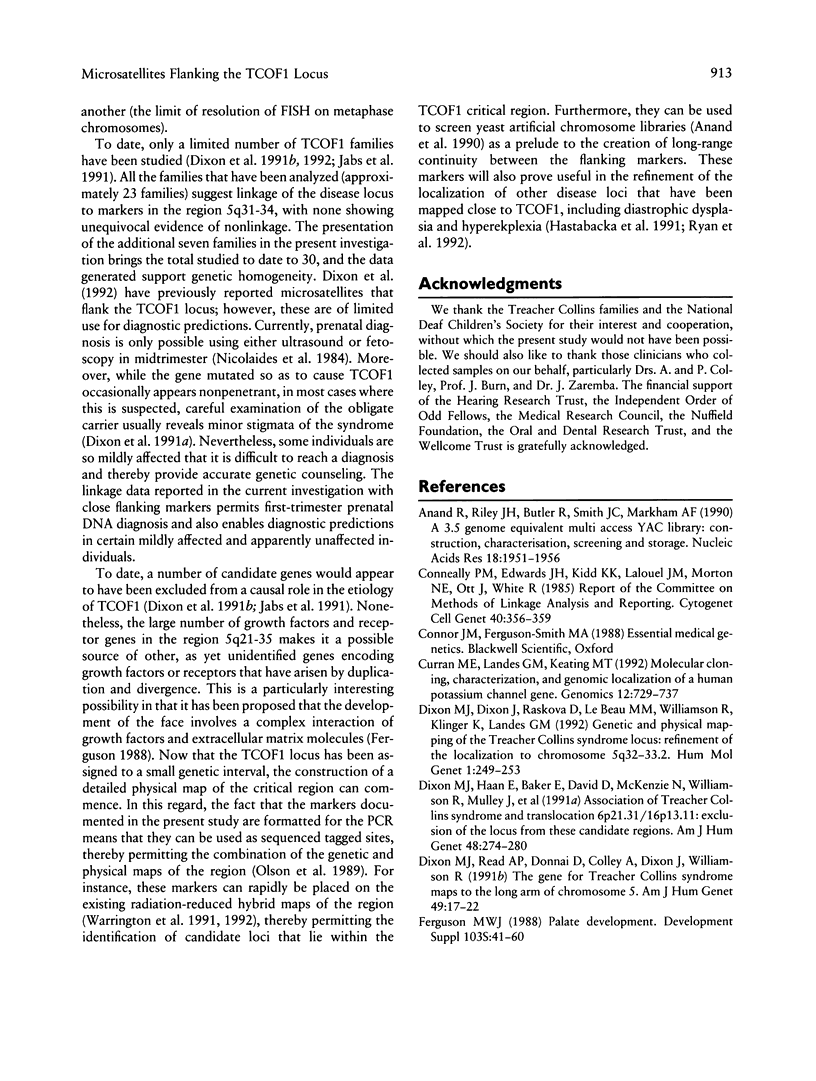
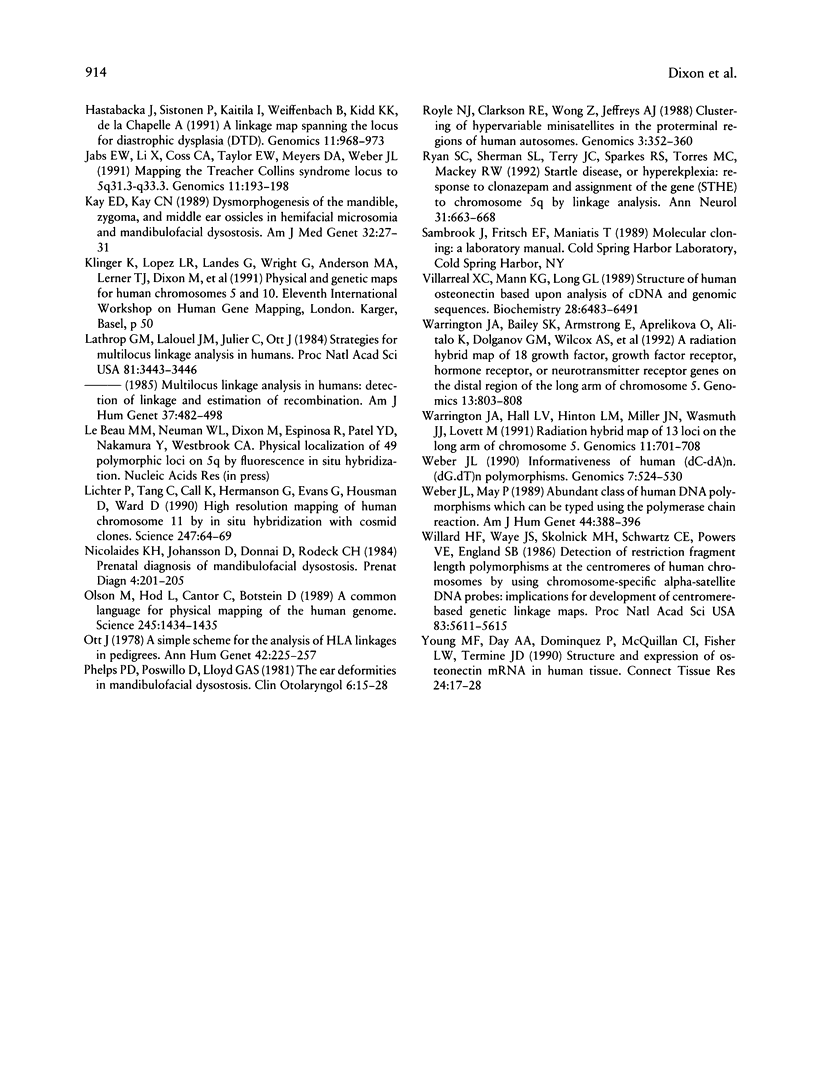
Images in this article
Selected References
These references are in PubMed. This may not be the complete list of references from this article.
- Anand R., Riley J. H., Butler R., Smith J. C., Markham A. F. A 3.5 genome equivalent multi access YAC library: construction, characterisation, screening and storage. Nucleic Acids Res. 1990 Apr 25;18(8):1951–1956. doi: 10.1093/nar/18.8.1951. [DOI] [PMC free article] [PubMed] [Google Scholar]
- Conneally P. M., Edwards J. H., Kidd K. K., Lalouel J. M., Morton N. E., Ott J., White R. Report of the Committee on Methods of Linkage Analysis and Reporting. Cytogenet Cell Genet. 1985;40(1-4):356–359. doi: 10.1159/000132186. [DOI] [PubMed] [Google Scholar]
- Dixon M. J., Dixon J., Raskova D., Le Beau M. M., Williamson R., Klinger K., Landes G. M. Genetic and physical mapping of the Treacher Collins syndrome locus: refinement of the localization to chromosome 5q32-33.2. Hum Mol Genet. 1992 Jul;1(4):249–253. doi: 10.1093/hmg/1.4.249. [DOI] [PubMed] [Google Scholar]
- Dixon M. J., Haan E., Baker E., David D., McKenzie N., Williamson R., Mulley J., Farrall M., Callen D. Association of Treacher Collins syndrome and translocation 6p21.31/16p13.11: exclusion of the locus from these candidate regions. Am J Hum Genet. 1991 Feb;48(2):274–280. [PMC free article] [PubMed] [Google Scholar]
- Dixon M. J., Read A. P., Donnai D., Colley A., Dixon J., Williamson R. The gene for Treacher Collins syndrome maps to the long arm of chromosome 5. Am J Hum Genet. 1991 Jul;49(1):17–22. [PMC free article] [PubMed] [Google Scholar]
- Ferguson M. W. Palate development. Development. 1988;103 (Suppl):41–60. doi: 10.1242/dev.103.Supplement.41. [DOI] [PubMed] [Google Scholar]
- Hästbacka J., Sistonen P., Kaitila I., Weiffenbach B., Kidd K. K., de la Chapelle A. A linkage map spanning the locus for diastrophic dysplasia (DTD). Genomics. 1991 Dec;11(4):968–973. doi: 10.1016/0888-7543(91)90021-6. [DOI] [PubMed] [Google Scholar]
- Jabs E. W., Li X., Coss C. A., Taylor E. W., Meyers D. A., Weber J. L. Mapping the Treacher Collins syndrome locus to 5q31.3----q33.3. Genomics. 1991 Sep;11(1):193–198. [PubMed] [Google Scholar]
- Kay E. D., Kay C. N. Dysmorphogenesis of the mandible, zygoma, and middle ear ossicles in hemifacial microsomia and mandibulofacial dysostosis. Am J Med Genet. 1989 Jan;32(1):27–31. doi: 10.1002/ajmg.1320320107. [DOI] [PubMed] [Google Scholar]
- Lathrop G. M., Lalouel J. M., Julier C., Ott J. Strategies for multilocus linkage analysis in humans. Proc Natl Acad Sci U S A. 1984 Jun;81(11):3443–3446. doi: 10.1073/pnas.81.11.3443. [DOI] [PMC free article] [PubMed] [Google Scholar]
- Lichter P., Tang C. J., Call K., Hermanson G., Evans G. A., Housman D., Ward D. C. High-resolution mapping of human chromosome 11 by in situ hybridization with cosmid clones. Science. 1990 Jan 5;247(4938):64–69. doi: 10.1126/science.2294592. [DOI] [PubMed] [Google Scholar]
- Nicolaides K. H., Johansson D., Donnai D., Rodeck C. H. Prenatal diagnosis of mandibulofacial dysostosis. Prenat Diagn. 1984 May-Jun;4(3):201–205. doi: 10.1002/pd.1970040307. [DOI] [PubMed] [Google Scholar]
- Olson M., Hood L., Cantor C., Botstein D. A common language for physical mapping of the human genome. Science. 1989 Sep 29;245(4925):1434–1435. doi: 10.1126/science.2781285. [DOI] [PubMed] [Google Scholar]
- Ott J. A simple scheme for the analysis of HLA linkages in pedigrees. Ann Hum Genet. 1978 Oct;42(2):255–257. doi: 10.1111/j.1469-1809.1978.tb00657.x. [DOI] [PubMed] [Google Scholar]
- Phelps P. D., Poswillo D., Lloyd G. A. The ear deformities in mandibulofacial dysostosis (Treacher Collins syndrome). Clin Otolaryngol Allied Sci. 1981 Feb;6(1):15–28. doi: 10.1111/j.1365-2273.1981.tb01782.x. [DOI] [PubMed] [Google Scholar]
- Royle N. J., Clarkson R. E., Wong Z., Jeffreys A. J. Clustering of hypervariable minisatellites in the proterminal regions of human autosomes. Genomics. 1988 Nov;3(4):352–360. doi: 10.1016/0888-7543(88)90127-9. [DOI] [PubMed] [Google Scholar]
- Ryan S. G., Sherman S. L., Terry J. C., Sparkes R. S., Torres M. C., Mackey R. W. Startle disease, or hyperekplexia: response to clonazepam and assignment of the gene (STHE) to chromosome 5q by linkage analysis. Ann Neurol. 1992 Jun;31(6):663–668. doi: 10.1002/ana.410310615. [DOI] [PubMed] [Google Scholar]
- Villarreal X. C., Mann K. G., Long G. L. Structure of human osteonectin based upon analysis of cDNA and genomic sequences. Biochemistry. 1989 Jul 25;28(15):6483–6491. doi: 10.1021/bi00441a049. [DOI] [PubMed] [Google Scholar]
- Warrington J. A., Bailey S. K., Armstrong E., Aprelikova O., Alitalo K., Dolganov G. M., Wilcox A. S., Sikela J. M., Wolfe S. F., Lovett M. A radiation hybrid map of 18 growth factor, growth factor receptor, hormone receptor, or neurotransmitter receptor genes on the distal region of the long arm of chromosome 5. Genomics. 1992 Jul;13(3):803–808. doi: 10.1016/0888-7543(92)90156-m. [DOI] [PubMed] [Google Scholar]
- Warrington J. A., Hall L. V., Hinton L. M., Miller J. N., Wasmuth J. J., Lovett M. Radiation hybrid map of 13 loci on the long arm of chromosome 5. Genomics. 1991 Nov;11(3):701–708. doi: 10.1016/0888-7543(91)90078-s. [DOI] [PubMed] [Google Scholar]
- Weber J. L. Informativeness of human (dC-dA)n.(dG-dT)n polymorphisms. Genomics. 1990 Aug;7(4):524–530. doi: 10.1016/0888-7543(90)90195-z. [DOI] [PubMed] [Google Scholar]
- Weber J. L., May P. E. Abundant class of human DNA polymorphisms which can be typed using the polymerase chain reaction. Am J Hum Genet. 1989 Mar;44(3):388–396. [PMC free article] [PubMed] [Google Scholar]
- Willard H. F., Waye J. S., Skolnick M. H., Schwartz C. E., Powers V. E., England S. B. Detection of restriction fragment length polymorphisms at the centromeres of human chromosomes by using chromosome-specific alpha satellite DNA probes: implications for development of centromere-based genetic linkage maps. Proc Natl Acad Sci U S A. 1986 Aug;83(15):5611–5615. doi: 10.1073/pnas.83.15.5611. [DOI] [PMC free article] [PubMed] [Google Scholar]
- Young M. F., Day A. A., Dominquez P., McQuillan C. I., Fisher L. W., Termine J. D. Structure and expression of osteonectin mRNA in human tissue. Connect Tissue Res. 1990;24(1):17–28. doi: 10.3109/03008209009152419. [DOI] [PubMed] [Google Scholar]



